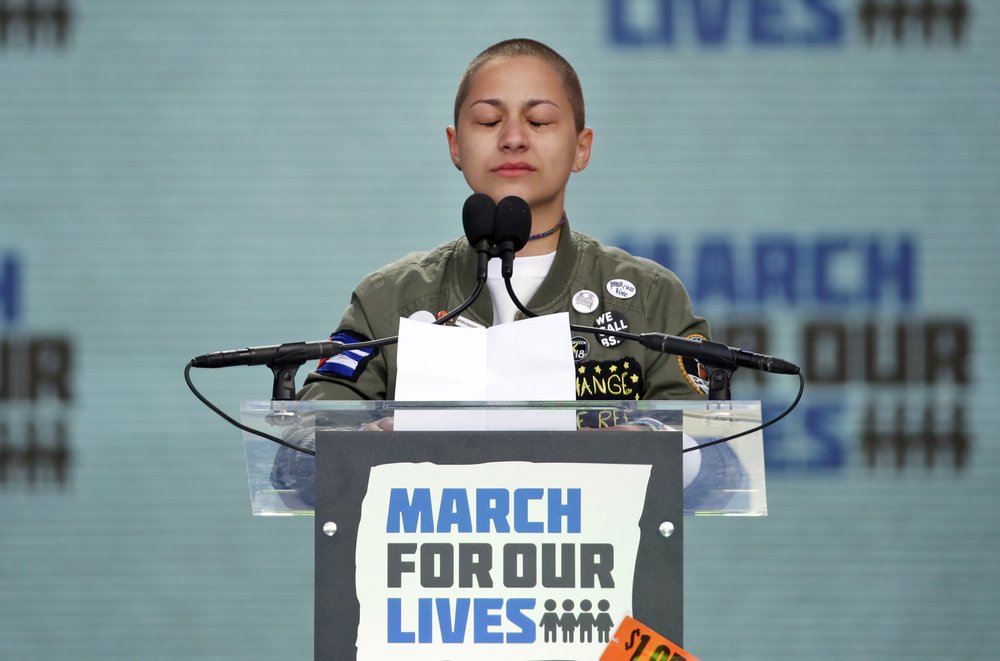Last year’s shooting at a Florida high school sparked a movement among a younger generation angered by gun violence and set the stage for a significant shift in America’s gun politics.
Thousands of student protesters took to the streets and inspired hashtags such as #NeverAgain and #Enough. They also mobilized to register a new generation of voters.
Candidates were emboldened too. Many of them confronted the issue in last year’s elections and were rewarded with victory over incumbents supported by the National Rifle Association. That helped Democrats take back control of the House.
“What we’ve seen here is a tectonic shift in our politics on the guns issue,” said Peter Ambler, executive director of Giffords, the gun violence prevention advocacy group founded by former Congresswoman Gabrielle Giffords. These people “didn’t get elected despite their advocacy for safer gun laws. They got elected because of their advocacy for safer gun laws. They made that a core part of their message to the American people.”
The political landscape began to change just days after a former student shot and killed 17 students and adults at Marjory Stoneman Douglas High School in Parkland, Florida.
At the state level, a surge of gun-control measures were enacted, including increasing the minimum age for purchasing a firearm and requiring waiting periods. The number of states with so-called “red flag” laws — which allow temporary confiscation of weapons from people deemed a safety risk — doubled.
At the federal level, for the first time in modern history, gun-control groups outspent the powerful NRA on the 2018 midterm elections. The new Democratic majority in the House this week held its first hearing on gun control in a decade.
Even under GOP-control of both chambers during President Donald Trump’s first two years in office, some of the gun industry’s top priorities — easing restrictions on firearm suppressors and making it easier to carry concealed firearms over state borders — stalled.
Still, with one of the most gun-friendly presidents in the White House, the U.S. Supreme Court now has a majority of justices who are viewed as ardent supporters of the Second Amendment, a shift that is likely to have a lasting effect on gun rights.
The most prominent shift occurred in Florida, a state that has long welcomed guns and has a strong NRA presence. Lawmakers raised the gun-purchasing age and imposed a three-day waiting period.
The Parkland attack came just a few months after two other gun tragedies: the deadliest mass shooting in modern U.S. history that killed 59 people at an outdoor concert in Las Vegas and the slayings of 26 churchgoers in Sutherland Springs, Texas.
In the wake of those massacres, the NRA’s influence waned. Trump directed the Justice Department to ban bump stocks, the device used by the Las Vegas gunman that allowed his rifles to mimic fully automatic weaponry.
The NRA also faced boycotts from corporate America, with some financial firms refusing to do business with gunmakers and some retailers pulling firearms and ammunition off shelves. A federal investigation into Russian meddling in the 2016 election widened to include suspicions that agents sought to court NRA officials and funnel money through the group.
The NRA has cast itself as being in financial distress because of deep-pocketed liberal opposition to guns and what it calls “toxic lies” in news reports. Last summer, the organization raised its annual dues for the second time in two years.
Parkland “definitely marked a turning point,” said Adam Winkler, a professor at the University of California Los Angeles School of Law and gun rights expert. “There is no doubt that the energy, the enthusiasm, the mobilization of these students was very influential. It did affect a lot of people across the country.”
But, he said, the NRA “remains a powerhouse,” and it’s too early to suggest that gun groups’ troubles are insurmountable.
“No one ever made a lot of money betting against the NRA,” he said.
The NRA did not immediately return messages seeking comment. However, Erich Pratt, executive director of Gun Owners of America, said the industry is accustomed to people believing the latest shooting will bring the gun industry to its knees.
“They said that in 2013 after the Sandy Hook shooting, and they absolutely said that again last year,” Pratt said. With the exception of Florida, the blue states got bluer and the red states got redder and expanded gun rights, he said.
Polls show that gun control is not a top priority for Americans, he said.
“I don’t think the needle has moved at all,” Pratt said.
(AP)











